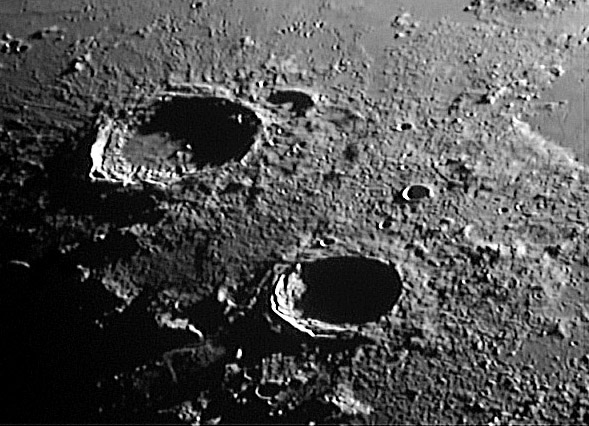Difference between revisions of "June 18, 2004"
| (2 intermediate revisions by the same user not shown) | |||
| Line 1: | Line 1: | ||
__NOTOC__ | __NOTOC__ | ||
=Frigid Buddies: Aristoteles and Eudoxus= | =Frigid Buddies: Aristoteles and Eudoxus= | ||
| + | <!-- Start of content --> | ||
<table width="640" border="0" align="center" cellpadding="6" cellspacing="2"> | <table width="640" border="0" align="center" cellpadding="6" cellspacing="2"> | ||
<tr> | <tr> | ||
| Line 21: | Line 22: | ||
Cristian's low Sun view was obtained May 25, 2004 when the seeing was excellent. He used a 25 cm Newtonian telescope with a Vesta Pro webcam; 300 out of 450 frames were combined with the IRIS software.</p> | Cristian's low Sun view was obtained May 25, 2004 when the seeing was excellent. He used a 25 cm Newtonian telescope with a Vesta Pro webcam; 300 out of 450 frames were combined with the IRIS software.</p> | ||
<p class="story"><b>Related Links:</b><br> | <p class="story"><b>Related Links:</b><br> | ||
| − | [ | + | [http://www.lpi.usra.edu/research/lunar_orbiter/images/img/iv_098_h3.jpg Aristoteles: Lunar Orbiter IV View]<br> |
| − | [ | + | [http://www.lpi.usra.edu/research/lunar_orbiter/images/img/iv_098_h2.jpg Eudoxus: Lunar Orbiter IV View ] |
</p> | </p> | ||
<p><b>Yesterday's LPOD:</b> [[June 17, 2004|Marsh of Epidemics]] </p> | <p><b>Yesterday's LPOD:</b> [[June 17, 2004|Marsh of Epidemics]] </p> | ||
| Line 48: | Line 49: | ||
<!-- Cleanup of credits --> | <!-- Cleanup of credits --> | ||
<p> </p> | <p> </p> | ||
| − | + | <!-- End of content --> | |
| − | + | {{wiki/ArticleFooter}} | |
| − | |||
| − | |||
| − | <!-- | ||
| − | |||
| − | |||
| − | |||
| − | |||
| − | |||
| − | |||
| − | |||
Latest revision as of 21:39, 8 February 2015
Frigid Buddies: Aristoteles and Eudoxus
Image Credit: Cristian Fattinnanzi |
|
Frigid Buddies: Aristoteles and Eudoxus Aristoteles and Eudoxus are two of the largest young craters in the north polar region of the Moon. Aristoteles is 87 km wide and Eudoxus has a diameter of 67 km. These craters look pretty similar, both have terraced walls and hilly floors, apparently veneered with some smooth material - perhaps impact melt. Which is youngest? The larger crater has radial ejecta and secondary craters on nearby Mare Frigoris. These are seen more clearly on the Lunar Orbiter IV frame. Because Eudoxus formed on rubbly Imbrium ejecta, its secondary craters are harder to recognize. The US Geological Survey assigns Eudoxus a stratigraphic age of Copernican, whereas Aristoteles is Eratosthenian. This means that Eudoxus is younger than 1.1 billion years old, and Aristoteles is somewhere between 1.1 and 3.2 b.y. old. Since both craters have about the same number of superposed (subsequent) impact craters, the two craters must be very near the Copernican-Eratosthenian boundary, with one slightly older and the other slightly younger. Technical Details: Related Links: Yesterday's LPOD: Marsh of Epidemics Tomorrow's LPOD: Janssen |
Author & Editor:
COMMENTS?Register, Log in, and join in the comments.
|




